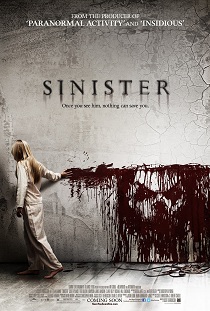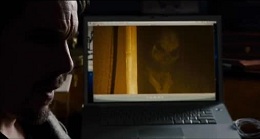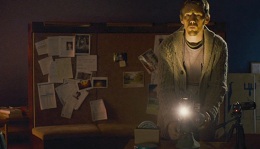Sinister is a new horror film that that feels fresh in large part because of how much it doesn’t resemble what the horror genre has become.
 It’s more influenced by the pacing and human drama of The Exorcist and The Shining than the sea of safe and soft PG-13 films or vapid remakes and prequels starring mid-tier TV stars the studios have been dumping in theaters. In this case, looking back is a welcome change.
It’s more influenced by the pacing and human drama of The Exorcist and The Shining than the sea of safe and soft PG-13 films or vapid remakes and prequels starring mid-tier TV stars the studios have been dumping in theaters. In this case, looking back is a welcome change.
Ellison Oswalt (Ethan Hawke in his first horror role), is a true crime writer so desperate for his fourth book to be as big as his first that he moves his family into the very house where four members of a family were murdered in their backyard. A fifth, a young girl, is missing. Oswalt is convinced the police have overlooked something, and is determined to solve the mystery.
In the attic he discovers an old box labeled “home movies” containing a super 8 projector and film reels innocuously labeled things such as “Lawn Work ’86” and “BBQ ’79.” However the contents are anything but innocuous, with each documenting the murder of a different family. His initial reaction is to share the evidence with the police, but then his vanity and his need to provide for his family win out and he decides to delay calling while he pours over the found footage.
Being a true crime writer, Oswalt completely rules out a supernatural explanation, which becomes harder to accept as more inexplicable things happen in his house, some even involving his children. Has he endangered his family and himself? Can he make things right?
 Hawke sells the hubris while also keeping the film grounded. Because we want to discover the secret behind the film just as much as he does, we’re complicit in his duplicity with his wonderfully supportive, if willfully in-the-dark, wife Tracy (Juliet Raylance).
Hawke sells the hubris while also keeping the film grounded. Because we want to discover the secret behind the film just as much as he does, we’re complicit in his duplicity with his wonderfully supportive, if willfully in-the-dark, wife Tracy (Juliet Raylance).
It all adds up to a film that is part psychological horror, part ghost story, and part subversion of the entire found-footage concept. Its decision to focus on a father possibly losing his grip on reality instead of nubile young high school or college students also help the proceedings feel much more mature and adult. There’s one scene in particular between the leads that is completely raw and honest but more importantly earned.
 It’s this character building and attention to detail that helps elevate Sinister to a different tier in the horror genre. Sure, it relies partially on jump scares and explosive sound design, but none of it feels like cheap fake-outs. It has creepy atmosphere to spare and actually marks a welcome return to using tripods instead of relying on frantic handheld camera work and fast cuts. The performances are also uniformly good, including a remarkably amusing turn by James Ransone as a sycophantic deputy.
It’s this character building and attention to detail that helps elevate Sinister to a different tier in the horror genre. Sure, it relies partially on jump scares and explosive sound design, but none of it feels like cheap fake-outs. It has creepy atmosphere to spare and actually marks a welcome return to using tripods instead of relying on frantic handheld camera work and fast cuts. The performances are also uniformly good, including a remarkably amusing turn by James Ransone as a sycophantic deputy.
Sinister may not be revolutionary, but it’s the rare example of a truly disturbing and scary horror film that achieves its scares by building up its characters and taking its time unraveling the central mystery. And while some will see it coming, it doesn’t make the chilling conclusion any less affecting.
Disclosure: I am personally acquainted with co-writer C. Robert Cargill, who is a fixture of the Austin film-going community.
This review was from Fantastic Fest 2012 in Austin, TX. Full Fantastic Fest coverage < ---






Comments on this entry are closed.